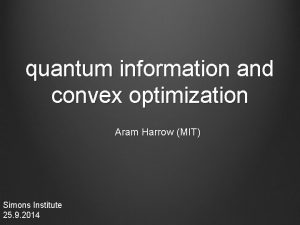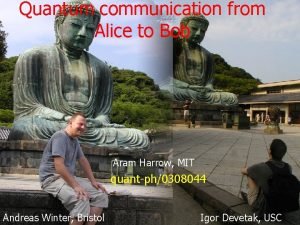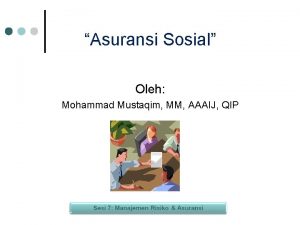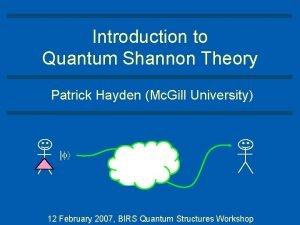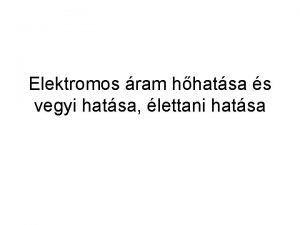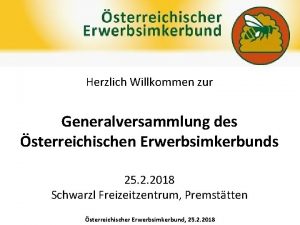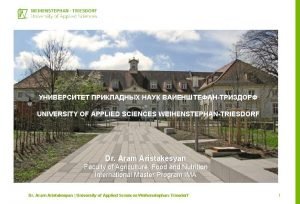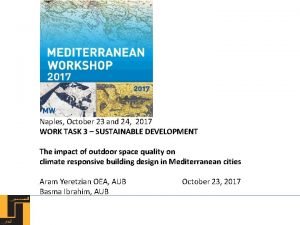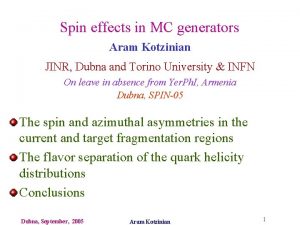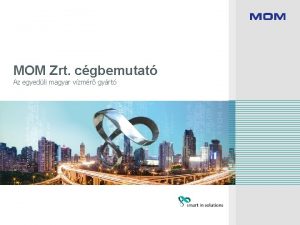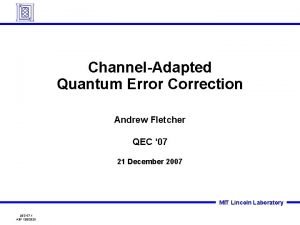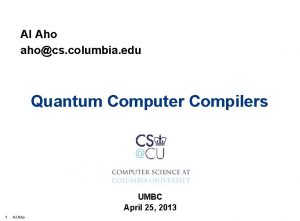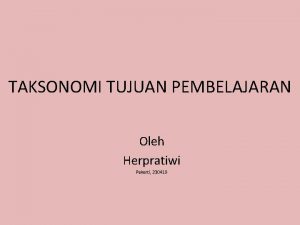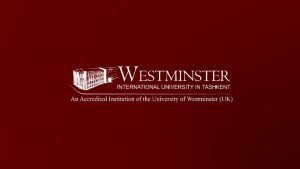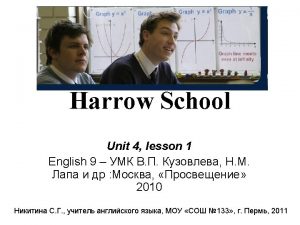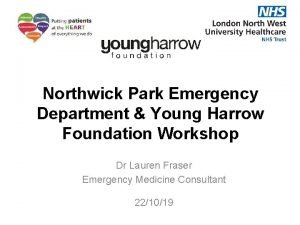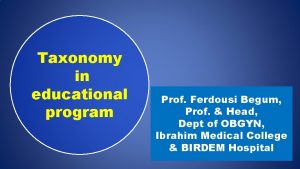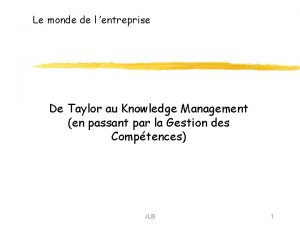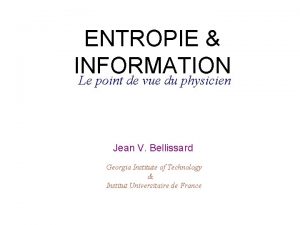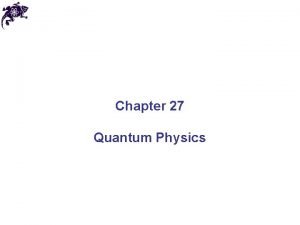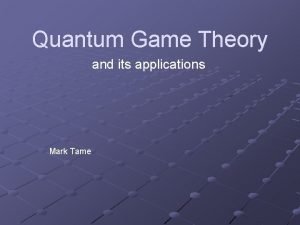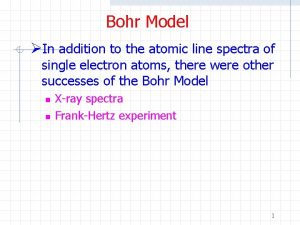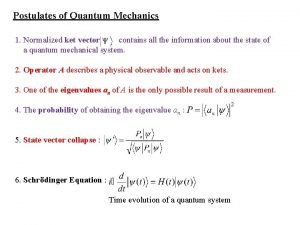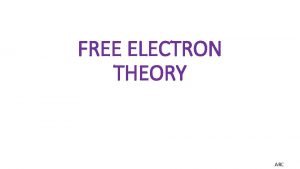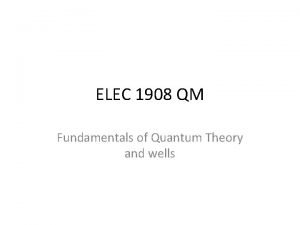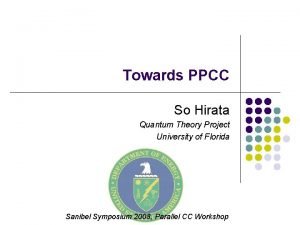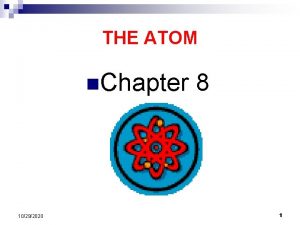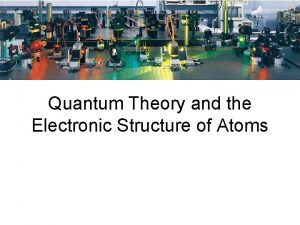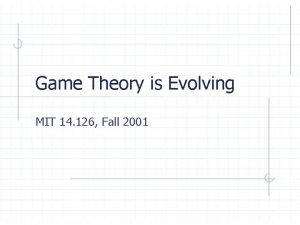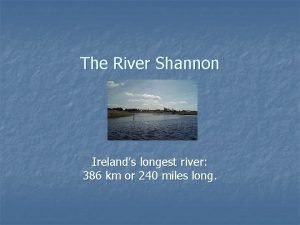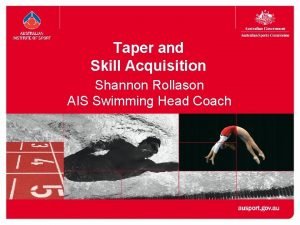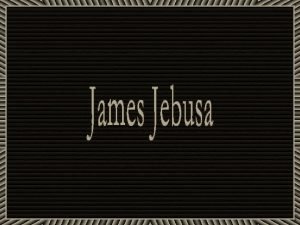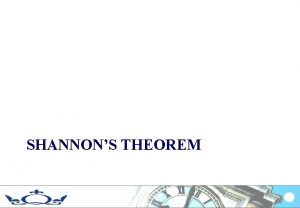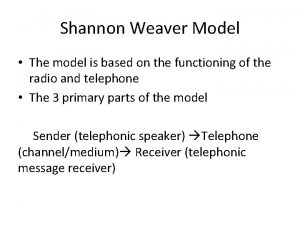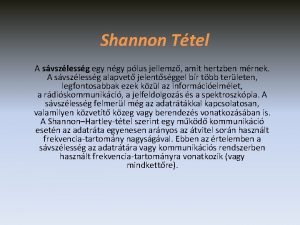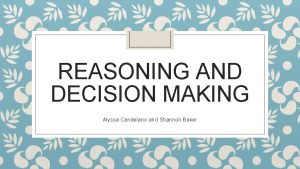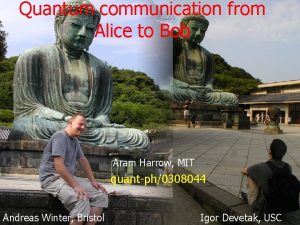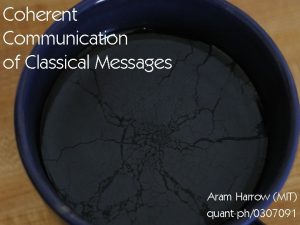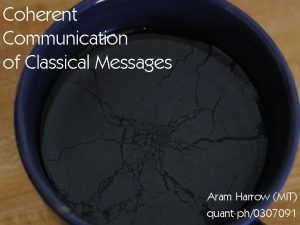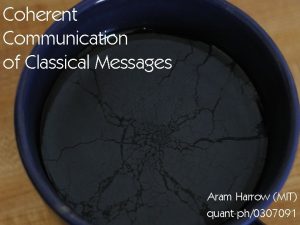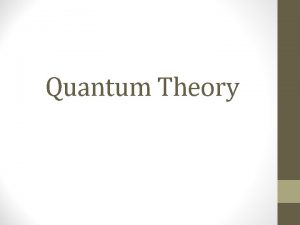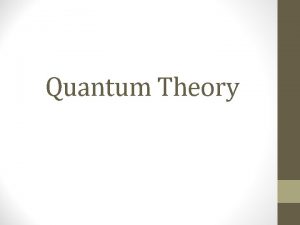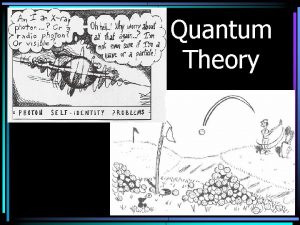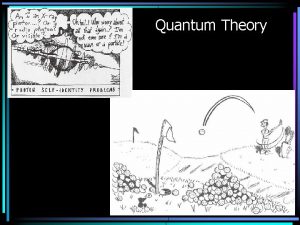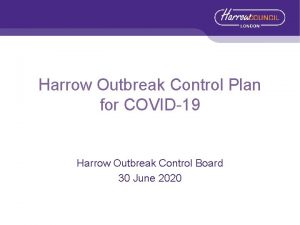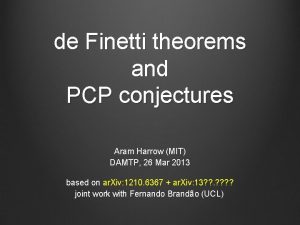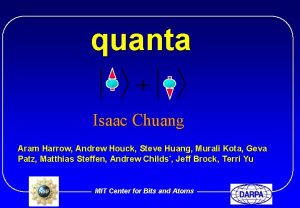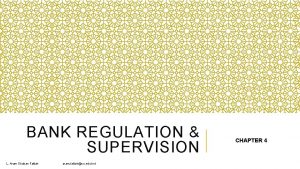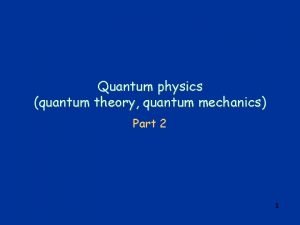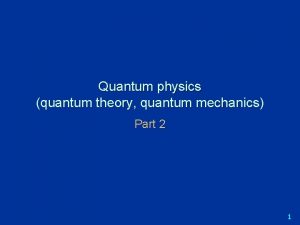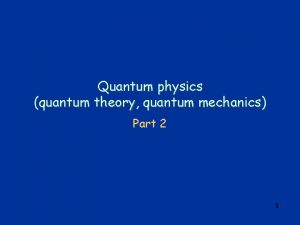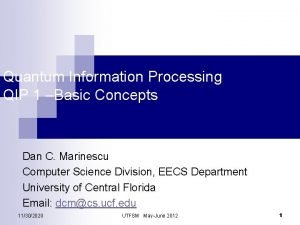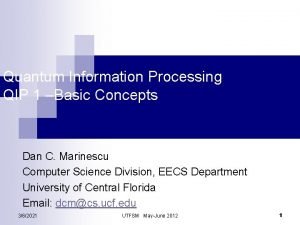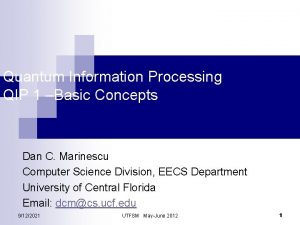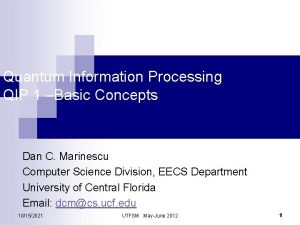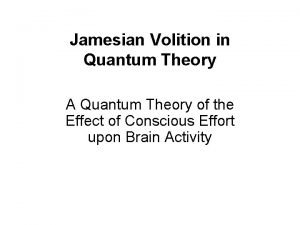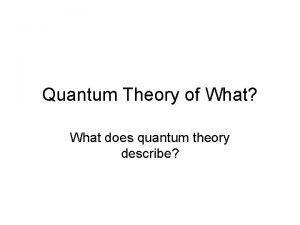Quantum Shannon Theory Aram Harrow MIT QIP 2016






![modern QIT semiclassical • compression: S(ρ) = -tr [ρlog(ρ)] • CQ or QC channels: modern QIT semiclassical • compression: S(ρ) = -tr [ρlog(ρ)] • CQ or QC channels:](https://slidetodoc.com/presentation_image_h/73c648207a23601381990454d103779f/image-7.jpg)












![entropy • • S(ρ) = -tr [ρlog ρ] range: 0 ≤ S(ρ) ≤ log(d) entropy • • S(ρ) = -tr [ρlog ρ] range: 0 ≤ S(ρ) ≤ log(d)](https://slidetodoc.com/presentation_image_h/73c648207a23601381990454d103779f/image-20.jpg)
















![state redistribution Reference |ψ� RABC [Luo-Devetak, Devetak-Yard] R A A C |Φ� M Alice state redistribution Reference |ψ� RABC [Luo-Devetak, Devetak-Yard] R A A C |Φ� M Alice](https://slidetodoc.com/presentation_image_h/73c648207a23601381990454d103779f/image-37.jpg)

![approximate Markov states towards a structure thm: [Fawzi-Renner 1410. 0664, others] If I(A: C|B) approximate Markov states towards a structure thm: [Fawzi-Renner 1410. 0664, others] If I(A: C|B)](https://slidetodoc.com/presentation_image_h/73c648207a23601381990454d103779f/image-39.jpg)



- Slides: 42

Quantum Shannon Theory Aram Harrow (MIT) QIP 2016 tutorial 9 -10 January, 2016

the prehistory of quantum information ideas present in disconnected form • 1927 Heisenberg uncertainty principle • 1935 EPR paper / 1964 Bell’s theorem • 1932 von Neumann entropy subadditivity (Araki-Lieb 1970) strong subadditivity (Lieb-Ruskai 1973) • measurement theory (Helstrom, Holevo, Uhlmann, etc. , 1970 s)

relativity: a close relative • Before Einstein, Maxwell’s equations were known to be incompatible with Galilean relativity. • Lorentz proposed a mathematical fix, but without the right physical interpretation. • Einstein’s solution redefined space/time, mass/momentum/energy, etc. • Space and time had solid mathematical foundations (Descartes, etc. ), unlike information and computing.

theory of information and computing • 1948 Shannon created modern information theory (and to some extent cryptography) and justified entropy as a measure of information independent of physics. units of bits. • Turing, Church, von Neumann, . . . , Djikstra described a theory of computation, algorithms, complexity, etc. • This made it possible to formulate questions such as: how do “quantum effects” change the capacity? ( Holevo bound) what is thermodynamic cost of computing? (Landauer principle, Bennett reversible computing) what is the computational complexity of simulating QM? ( DMRG/QMC, and also Feynman)

some wacky ideas Feynman ’ 82: “Simulating Physics with Computers” • Classical computers require exponential overhead to simulate quantum mechanics. • But quantum systems obviously don’t need exp overhead to simulate themselves. • Therefore they are doing something more computationally powerful than our existing computers. • (Implicitly requires the idea of a universal Turing machine, and the strong Church-Turing thesis. ) Wiesner ’ 70: “Conjugate Coding” • The uncertainty principle restricts possible measurements. • In experiments, this is a disadvantage, but in crypto, limiting information is an advantage. • (Requires crypto framework, notion of “adversary. ”) • Paper initially rejected by IEEE Trans. Inf. Th. ca. 1970

towards modern QIT • Deutsch, Jozsa, Bernstein, Vazirani, Simon, etc. – impractical speedups required oracle model, precursors to Shor’s algorithm, following Feynman. • quantum key distribution (BB 84, B 90, E 91) – following Weisner. • ca. 1995 • Shor and Grover algorithms • quantum error-correcting codes • fault-tolerant quantum computing • teleportation, super-dense coding • Schumacher-Jozsa data compression • HSW coding theorem • resource theory of entanglement
![modern QIT semiclassical compression Sρ tr ρlogρ CQ or QC channels modern QIT semiclassical • compression: S(ρ) = -tr [ρlog(ρ)] • CQ or QC channels:](https://slidetodoc.com/presentation_image_h/73c648207a23601381990454d103779f/image-7.jpg)
modern QIT semiclassical • compression: S(ρ) = -tr [ρlog(ρ)] • CQ or QC channels: χ({px, ρx}) = S(∑x pxρx) - ∑xpx. S(ρx) • hypothesis testing: D(ρ||σ) = tr[ρ(log(ρ) - log(σ)] “fully quantum” • complementary channel: N(ρ) = tr 2 VρV†, Nc(ρ) : = tr 1 VρV† • quantum capacity: Q(1)(N) = maxρ [S(N(ρ)) - S(Nc(ρ))] Q(N) = limn ∞ Q(1)(N⊗n )/n • tools: purifications (Stinespring), decoupling recent • one-shot: Sα(ρ) : = log(tr ρα)/(1 -α) • applications to optimization, condensed matter, stat mech.

Relevant talks • Wed 9. Omar Fawzi and Renato Renner. Quantum conditional mutual information and approximate Markov chains. • Wed 9: 50. Omar Fawzi, Marius Junge, Renato Renner, David Sutter, Mark Wilde and Andreas Winter. Universal recoverability in quantum information theory. • Thurs 11. David Sutter, Volkher Scholz, Andreas Winter and Renato Renner. Approximate degradable quantum channels • Thurs 4: 15. Mario Berta, Joseph M. Renes, Marco Tomamichel, Mark Wilde and Andreas Winter. Strong Converse and Finite Resource Tradeoffs for Quantum Channels.

semi-relevant talks • Tues 11: 50. Ryan O'Donnell and John Wright. Efficient quantum tomography merged with Jeongwan Haah, Aram Harrow, Zhengfeng Ji, Xiaodi Wu and Nengkun Yu. Sample-optimal tomography of quantum states • Tues 3: 35. Ke Li. Discriminating quantum states: the multiple Chernoff distance • Thurs 10. Mark Braverman, Ankit Garg, Young Kun Ko, Jieming Mao and Dave Touchette. Near optimal bounds on bounded-round quantum communication complexity of disjointness • Thurs 3: 35. Fernando Brandao and Aram Harrow. Estimating operator norms using covering nets with applications to quantum information theory • Thurs 4: 15. Michael Beverland, Gorjan Alagic, Jeongwan Haah, Gretchen Campbell, Ana Maria Rey and Alexey Gorshkov. Implementing a quantum algorithm for spectrum estimation with alkaline earth atoms.

outline • metrics • compressing quantum ensembles (Schumacher coding) • sending classical messages over q channels (HSW) • remote state preparation (RSP) • Schur duality • RSP and the strong converse • hypothesis testing • merging • quantum conditional mutual information and q Markov states

metrics Trace distance T(ρ, σ) : = ½ || ρ-σ ||1 • Is a metric. • monotone: T(ρ, σ) ≥ T(N(ρ), N(σ)) • and this is achieved by a measurement T = max m’mt bias Fidelity • F=1 iff ρ=σ and F=0 iff ρ⊥σ • monotone F(ρ, σ) ≤ F(N(ρ), N(σ)) • and this is achieved by a measurement! Relation: 1 -F ≤ T ≤ (1 -F 2)1/2 Pure states with angle θ: F = cos(θ) and T = sin(θ). (exercise: which m’mts saturate? )

the case for fidelity Uhlmann’s theorem: F(ρA, σA) = maxψ, φ F(ψAB, φAB) s. t. ψ=|ψ��ψ|, φ=|φ��φ|, σ A. A = ρA, φA =ψ Note: 1. ≥ from monotonicity. = requires sweat Church of the Larger Hilbert Space 2. Can fix either ψ or φ and max over the other. 3. F(ψ, φ) = |�ψ|φ�|. (Some use different convention. ) 4. Implies that (1 -F)1/2 is a metric. Also F is multiplicative.

Compression |ψx�∈Cd with prob px encoder decoder dim r<d Average fidelity: ∑x px F(ψx, D(E(ψx))) ≤ F(ρ, D(E(ρ))) Simplification: use ensemble density matrix ρ = ∑x px ψx with eigenvalues λ 1 ≥ λ 2 ≥. . . ≥ λd ≥ 0 2 ≤ tr [P ρ] = λ +. . . + λ rank(σ)=r ⇒ F(ρ, σ) r 1 r Pr projects onto top r eigenvectors Suggests optimal fidelity = (λ 1 +. . . + λr)1/2. ≈|ψx�

Too good to be true! Ensemble density matrix: ρ = ∑x px ψx Yes compression depends only on ρ. But reproducing ρ is not enough! consider: E(∙)=|0�� 0| D(∙)=ρ Gets the average right but not the correlations.

Reference system Average fidelity: ∑x px F(ψx, E(D(ψx))) = F(∑x px |x��x| x, ⊗∑ψ x px |x��x| ⊗ E(D(ψ x))) Not so easy to analyze. Instead follow the Church of the Larger Hilbert Space. Avg fidelity ≥ F(��, D∘E Q)(��)) R ⊗(id (pf: monotonicity under map that measures R. ) Protocol: E(ω) = Pr ω Pr. D = id. achieves F = ���| r)(I|��� ⊗ P = r]tr = λ[ρP 1 +. . . + λr

Optimality Complication: E, D might be noisy. Solution: purify! 1. Write D(E(ω)) = tr. G VωV† where V is an isometry from Q -> Q⊗G. 2. Uhlmann F(��, tr = � 0| |���| G V��V†) RQ G V |��� RQ| 3. a little linear algebra F ≤ tr[ρP] for P rank-r and ||P||≤ 1 ≤ λ 1 +. . . + λr

compressing i. i. d. sources Quantum story ≈ classical story n. ρ⊗n has eigenvalues λx 1 λx 2 ⋅⋅⋅ λxn for X=(x 1, . . . , xn) ∈ [d] Typically this is ≈ H(λ) = -∑x λx log(λx) = S(ρ) = -tr[ρlog(ρ)] distribution of -log(λx 1 λx 2 ⋅⋅⋅ λxn ) n. H(λ) σ2=∑x λx (log(1/λx)-H)2 qubits fidelity n. H(λ) + 2σn 1/2 0. 98 n. H(λ) - 2σn 1/2 0. 02 n(H(λ)+δ) 1 -exp(-nδ 2/2σ2) n(H(λ)-δ) exp(-nδ 2/2σ2)

typicality Definitions: An eigenvector of ρ⊗n is k-typical if its eigenvalue is in the range exp(-n. S(ρ) ± kσn 1/2). Typical subspace V = span of typical eigenvectors Typical projector P = projector onto V Structure theorem for iid states: “asymptotic equipartition” • tr [Pρ⊗n ] ≥ 1 – k-2 • exp(-n. S(ρ) - kσn 1/2) P ≤ Pρ⊗n P ≤ exp(-n. S(ρ) + kσn 1/2) P • likewise tr[P] ≈ exp(n. S(ρ) + kσn 1/2) Almost flat spectrum. Plausible because of permutation symmetry.

Quantum Shannon Theory Aram Harrow (MIT) QIP 2016 tutorial day 2 10 January, 2016
![entropy Sρ tr ρlog ρ range 0 Sρ logd entropy • • S(ρ) = -tr [ρlog ρ] range: 0 ≤ S(ρ) ≤ log(d)](https://slidetodoc.com/presentation_image_h/73c648207a23601381990454d103779f/image-20.jpg)
entropy • • S(ρ) = -tr [ρlog ρ] range: 0 ≤ S(ρ) ≤ log(d) symmetry: S(ρ) = S(UρU†) multiplicative: S(ρ⊗σ) = S(ρ) + S(σ) continuity (Fannes-Audenaert): | S(ρ) – S(σ) | ≤ εlog(d) + H(ε, 1 -ε) ε : = || ρ – σ ||1 / 2 S(A|B) A B I(A: B) A • multipartite systems: ρAB S(A) = S(ρA), S(B) = S(ρB), etc. • conditional entropy: S(A|B) : = S(AB) – S(B), can be < 0 • mutual information: I(A: B) = S(A) + S(B) – S(AB) = S(A) – S(A|B) = S(B) – S(B|A) ≥ 0 “subadditivity” B

CQ channel coding CQ = Classical input, Quantum output |x��x| N ρx = N(|x��x|) Given n uses of N, how many bits can we send? Allow error that 0 as n ∞. HSW theorem: Capacity = maxχ χ({px, ρx}) = S(∑x pxρx) - ∑xpx. S(ρx) ωXQ = ∑x px |x��x|x ⊗ρ χ = I(X; Q)ω = S(Q) – S(Q|X)

HSW coding ρ = Σ x px ρ x χ = S(ρ) - Σx px S(ρx) = S(Q) – S(Q|X) total information typical subspace of ρ⊗n has dim ≈exp(n S(ρ)) ambiguity in each message If x=(x 1, . . . , xn) is p-typical then ρx 1 ⊗ρx 2 ⊗. . . x⊗ρ has typical subspace n of dim ≈ exp(n∑x px S(ρx)) “Packing lemma” Can fit ≈exp(nχ) messages.

Packing lemma Classically: random coding and maximum-likelihood decoding Quantumly: messages do not commute with each other density ≤ 1/D size ≤ d Suppose σ=Σx px σx and there exist Π, {Πx} s. t. 1. tr[Πσx] ≥ 1 -ε 2. tr[Πxσx] ≥ 1 -ε 3. tr[Πx] ≤ d 4. ΠσΠ ≤ Π / D Packing lemma: We can send M messages with error O(ε 1/2 + Md/D) For HSW: σ=ρ⊗n with typ proj Π. D ≈ exp(n S(Q)) σx = ρx 1 ⊗. . . x⊗ρ with typ proj Πx. d ≈ exp(n S(Q|X)). n

Upper bound ∑Y DY = I ρX = ρx 1 ⊗. . . x⊗ρ n X∈{X 1, . . . , XM} N⊗n D Q Y Pr[Y|X] = tr[ρXDY] proof: nχ ≥ I(X; Q) ≥ I(X; Y) ≥ (1 -O(ε)) log(M) continuity data-processing inequality additivity Wed 10: 50 Cross-Li-Smith. also Shannon 1948 Q Q D Y ≅ VD isometry Y Q’ I(X: Q) = I(X: YQ’) ≥ I(X: Y)

conditional mutual information Claim that I(A: BC) - I(A: B) ≥ 0. =: I(A: C|B) conditional mutual information = S(A|B) + S(C|B) – S(AC|B) = S(AB) + S(BC) – S(ABC) – S(B) B A CMI C If B is classical, ρ = ∑b p(b) |b��b| ⊗ AC σ(b) then I(A: C|B) = ∑b p(b) I(A: C)σ(b) ≥ 0 from subadditivity I(A: C|B) ≥ 0 is strong subadditivity [Lieb-Ruskai ’ 73]. I(A: C|B) = 0 for “quantum Markov states” Wed morning you will hear I(A: C|B) ≥ “non-Markovianity”

capacity of QQ channels Additional degree of freedom: channel inputs |ψx�. C(1)(N) = max{px, ψx} χ({px, ψx}) NP-hard optimization problem [Beigi-Shor, H. -Montanaro] Worse: C(N) = limn ∞ C(1)(N⊗n )/n. and ∃ channels where C(N) > C(1)(N). Open questions: Non-trivial upper bounds on capacity. Strong converse (psucc -> 0 when sending n(C+δ) bits. ) (see Berta et al, Thurs 4: 15 pm).

quantum capacity How many qubits can be sent through a noisy channel? R R A N B ≅ A VN B E isometry Q(1)(N) : = max S(B) – S(E) = max S(B) – S(RB) = max –S(R|B) “coherent information” Q(N) = limn ∞ Q(1)(N⊗n )/n not known when > 0. sometimes Q(1)(N)= 0 < Q(N).

entanglement-assisted capacity Alice and Bob share unlimited free EPR pairs. R A VN R CE(N) = max I(R: B) B QE(N) = CE(N)/2 Bennett Shor Smolin Thapliyal q-ph/0106052 E 1) additive 2) concave in input efficiently computable

covering lemma size ≤ D density≤ 1/d Suppose σ=Σx px σx and there exist Π, {Πx} s. t. 1. tr[Πσx] ≥ 1 -ε 2. tr[Πxσx] ≥ 1 -ε 3. tr[Π] ≤ D 4. ΠxσxΠx ≤ Πx / d Covering lemma: If x 1, . . . , x. M are sampled randomly from p and M >> (D/d) log(D)/ε 3 then with high probability

wiretap (CQQ) channel X N B E ρx. BE = N(|x��x|) Thm: Alice can send secret bits to Bob at rate I(X: B) – I(X: E). Proof: packing lemma -> coding ≈n. I(X: B) bits for Bob covering lemma -> sacrifice ≈n. I(X: E) bits to decouple Eve

remote state preparation (RSP) Q: Cost to transmit n qubits? A: 2 n cbits, n ebits using teleportation. Cost is optimal given super-dense coding and entanglement distribution. visible coding: What if the sender knows the state? We want to simulate the map: “ψ” |ψ�. Requires ≥n cbits, but above optimal arguments break.

RSP via covering Consider the ensemble {UψU†} for random U. Average state is I/2 n. Covering-type arguments [Aubrun ar. Xiv: 0805. 2900] If we choose U 1, . . . , UM randomly with M >> 2 n / ε 2 then with high probability, ∀ψ Set Then (1 -ε)I ≤ ∑i Ei ≤ I So {Ei} is ≈ a valid measurement. So what?

RSP finally recall T)|Φ Lemma: (A⊗I)|Φ A d� d� = (I ⊗ Protocol: {Ei. T } |Φ 2 n� AB discard i U i† ∝E i. T ⊗ Ei ∝ (UiψUi†)T ⊗ (UiψUi†) cost ≈ n cbits + n ebits. |ψ�

RSP of ensembles can simulate x -> ρx with cost χ ≈nχ cbits + some ebits ≥ N⊗n ≥ ≈nχcbits Lemma: Converting n(C-δ) cbits + ∞ ebits into n. C cbits will have success probability ≤exp(-nδ). implies strong converse: sending n(χ+δ) bits through N⊗n has exp(-nδ’) success prob

simulation and strong converses Let N be a general q channel. Type of simulation cbit simulation cost also needs visible product input χ EPR visible arbitrary input R EPR arbitrary quantum input CE embezzling R is “strong converse rate”; i. e. min s. t. sending n(R+δ) bits has success prob ≤ exp(-nδ’) χ ≤ C ≤ R ≤ CE

merging and decoupling Reference |ω� RA’MB R A’ A U |ψ� RAB Alice Bob |Φ� M |ψ� RAB B’ B V AB Let |ω�= U|ψ�. Claim: All we need is ωRA’ ≈ ωR ⊗ ωA’. Pf: The LHS is purified by |ω� and the RHS by |ψ� RAB|Φ� A’B’ Uhlmann’s theorem says ∃V: MB ABB’ making these close.
![state redistribution Reference ψ RABC LuoDevetak DevetakYard R A A C Φ M Alice state redistribution Reference |ψ� RABC [Luo-Devetak, Devetak-Yard] R A A C |Φ� M Alice](https://slidetodoc.com/presentation_image_h/73c648207a23601381990454d103779f/image-37.jpg)
state redistribution Reference |ψ� RABC [Luo-Devetak, Devetak-Yard] R A A C |Φ� M Alice Bob A’ U |ψ� RABC B’ B V BC |M| = ½ I(C: R|B) = ½ I(C: R|A) qubits communicated entanglement consumed/created = H(C|RB)

quantum Markov states relabel A B C E Bob can “redistribute” C to E with ½ I(A: C|B) qubits. If I(A: C|B)=0 then this is reversible! Implies recovery map R : B -> BC such that (id. A ⊗ RB->BC)(ρAB) = ρABC structure theorem: I(A: C|B)=0 iff B 1 L A B 2 L B 3 L B 4 L B 1 R B 2 R B 3 R B 4 R C
![approximate Markov states towards a structure thm FawziRenner 1410 0664 others If IA CB approximate Markov states towards a structure thm: [Fawzi-Renner 1410. 0664, others] If I(A: C|B)](https://slidetodoc.com/presentation_image_h/73c648207a23601381990454d103779f/image-39.jpg)
approximate Markov states towards a structure thm: [Fawzi-Renner 1410. 0664, others] If I(A: C|B) ≈ 0 then ∃approximate recovery map R, i. e. (id. A ⊗ RB->BC)(ρAB) ≈ ρABC states with low CMI appear in condensed matter, optimization, communication complexity, . . . structure theorem: I(A: C|B)=0 iff B 1 L A B 2 L B 3 L B 4 L B 1 R B 2 R B 3 R B 4 R C

Relevant talks • Wed 9. Omar Fawzi and Renato Renner. Quantum conditional mutual information and approximate Markov chains. • Wed 9: 50. Omar Fawzi, Marius Junge, Renato Renner, David Sutter, Mark Wilde and Andreas Winter. Universal recoverability in quantum information theory. • Thurs 11. David Sutter, Volkher Scholz, Andreas Winter and Renato Renner. Approximate degradable quantum channels • Thurs 4: 15. Mario Berta, Joseph M. Renes, Marco Tomamichel, Mark Wilde and Andreas Winter. Strong Converse and Finite Resource Tradeoffs for Quantum Channels. QCMI channel capacities

semi-relevant talks • Tues 11: 50. Ryan O'Donnell and John Wright. Efficient quantum tomography merged with Jeongwan Haah, Aram Harrow, Zhengfeng Ji, Xiaodi Wu and Nengkun Yu. Sample-optimal tomography of quantum states HSW metrics • Tues 3: 35. Ke Li. Discriminating quantum states: the multiple Chernoff distance • Thurs 10. Mark Braverman, Ankit Garg, Young Kun Ko, Jieming Mao and Dave Touchette. Near optimal bounds on bounded-round quantum communication complexity of disjointness QCMI • Thurs 3: 35. Fernando Brandao and Aram Harrow. Estimating operator norms using covering nets with applications to quantum information theory covering • Thurs 4: 15. Michael Beverland, Gorjan Alagic, Jeongwan Haah, Gretchen Campbell, Ana Maria Rey and Alexey Gorshkov. Implementing a quantum algorithm for spectrum estimation with alkaline earth atoms. entropy

reference Mark Wilde. ar. Xiv: 1106. 1445. “From Classical to Quantum Shannon Theory” Last update Dec 2, 2015. 768 pages.
 Aram harrow mit
Aram harrow mit Aram harrow
Aram harrow Pengertian qip
Pengertian qip Quantum shannon theory
Quantum shannon theory Quantum physics vs quantum mechanics
Quantum physics vs quantum mechanics Quantum physics vs mechanics
Quantum physics vs mechanics Elektromos áram kémiai hatása
Elektromos áram kémiai hatása Aram ghadimi
Aram ghadimi Aram basmadjian
Aram basmadjian Aram yeretzian
Aram yeretzian Aram generator
Aram generator Mnk áram
Mnk áram Mit quantum computing
Mit quantum computing Mit quantum computing
Mit quantum computing Taksonomi psikomotor harrow
Taksonomi psikomotor harrow Dixie harrow
Dixie harrow Harrow lbc v shah
Harrow lbc v shah Harrow boarding school
Harrow boarding school Emergency care harrow
Emergency care harrow Harrow taxonomy
Harrow taxonomy Structure fonctionnelle taylor
Structure fonctionnelle taylor Anita harrow psychomotor domain
Anita harrow psychomotor domain Claude e shannon information theory
Claude e shannon information theory Dual nature of light
Dual nature of light Section 2 quantum theory and the atom
Section 2 quantum theory and the atom Mark tame
Mark tame Electrons in atoms section 2 quantum theory and the atom
Electrons in atoms section 2 quantum theory and the atom Moseley law formula
Moseley law formula Ket vector
Ket vector Salient features of quantum free electron theory
Salient features of quantum free electron theory Hydrogen wave function
Hydrogen wave function Quantum theory project
Quantum theory project Quantum theory of light
Quantum theory of light Quantum theory and the electronic structure of atoms
Quantum theory and the electronic structure of atoms Mit game theory
Mit game theory What counties does the shannon flow through
What counties does the shannon flow through Shannon rollason
Shannon rollason Violet rutland
Violet rutland Shannon hartley theorem
Shannon hartley theorem Shanon weaver model
Shanon weaver model Shannon tétel
Shannon tétel Shannon boardman
Shannon boardman Shannon candelario
Shannon candelario
